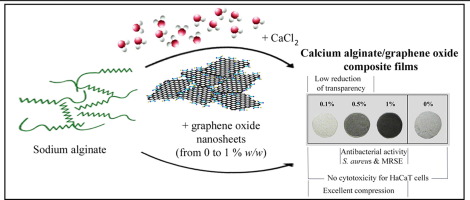当前位置:
X-MOL 学术
›
Eur. Polym. J.
›
论文详情
Our official English website, www.x-mol.net, welcomes your
feedback! (Note: you will need to create a separate account there.)
Calcium alginate/graphene oxide films: reinforced composites able to prevent Staphylococcus aureus and methicillin-resistant Staphylococcus epidermidis infections with no cytotoxicity for human keratinocyte HaCaT cells
European Polymer Journal ( IF 5.8 ) Pub Date : 2019-01-01 , DOI: 10.1016/j.eurpolymj.2018.11.012 Miguel Martí , Belén Frígols , Beatriz Salesa , Ángel Serrano-Aroca
European Polymer Journal ( IF 5.8 ) Pub Date : 2019-01-01 , DOI: 10.1016/j.eurpolymj.2018.11.012 Miguel Martí , Belén Frígols , Beatriz Salesa , Ángel Serrano-Aroca

|
Abstract The rapid emergence of drug resistance in pathogenic bacteria is becoming a serious global public health problem. Therefore, there is an imminent need of finding new alternative antibacterial approaches which are cost-effective and able to impede multi-drug resistant infections. Alginate is a low-cost material in comparison with other biopolymers, it is renewable and it possess excellent hydrophilicity, biocompatibility and biodegradability. Thus, in this study, alginate composite films were produced with calcium chloride as cross-linker and several low graphene oxide (GO) contents ranging from 0 to 1% w/w. These composites were tested against two clinically relevant pathogens, one of them multidrug-resistant, Staphylococcus aureus and methicillin-resistant Staphylococcus epidermidis, by two complementary antibacterial methods. The results of this study showed that the incorporation of a low amount of GO (0.5% w/w) can produce compression reinforced calcium alginate films with a low reduction of transparency and very high antibacterial activity against these two life-threatening pathogens. Furthermore, none of the extracts of these hydrophilic composite films caused any statistically significant cytotoxic effect in the presence of human keratinocyte HaCaT cells, which render these low-cost composites very promising for many bioengineering applications such as tissue engineering, wound healing and drug delivery systems.
中文翻译:

海藻酸钙/氧化石墨烯薄膜:增强复合材料,能够预防金黄色葡萄球菌和耐甲氧西林表皮葡萄球菌感染,对人角质形成细胞 HaCaT 细胞无细胞毒性
摘要 病原菌耐药性的迅速出现正在成为一个严重的全球公共卫生问题。因此,迫切需要寻找具有成本效益且能够阻止多重耐药性感染的新的替代抗菌方法。与其他生物聚合物相比,海藻酸盐是一种低成本材料,它是可再生的,并且具有优异的亲水性、生物相容性和生物降解性。因此,在这项研究中,海藻酸盐复合薄膜是用氯化钙作为交联剂和几种低氧化石墨烯 (GO) 含量范围从 0 到 1% w/w 生产的。通过两种互补的抗菌方法,对这些复合材料对两种临床相关病原体进行了测试,其中一种是耐多药的金黄色葡萄球菌和耐甲氧西林的表皮葡萄球菌。这项研究的结果表明,掺入少量 GO(0.5% w/w)可以产生压缩增强的海藻酸钙薄膜,对这两种威胁生命的病原体具有较低的透明度和非常高的抗菌活性。此外,这些亲水复合膜的提取物在人类角质形成细胞 HaCaT 细胞存在的情况下均未引起任何统计学上显着的细胞毒性作用,这使得这些低成本复合材料在许多生物工程应用中非常有前途,如组织工程、伤口愈合和药物输送系统.
更新日期:2019-01-01
中文翻译:

海藻酸钙/氧化石墨烯薄膜:增强复合材料,能够预防金黄色葡萄球菌和耐甲氧西林表皮葡萄球菌感染,对人角质形成细胞 HaCaT 细胞无细胞毒性
摘要 病原菌耐药性的迅速出现正在成为一个严重的全球公共卫生问题。因此,迫切需要寻找具有成本效益且能够阻止多重耐药性感染的新的替代抗菌方法。与其他生物聚合物相比,海藻酸盐是一种低成本材料,它是可再生的,并且具有优异的亲水性、生物相容性和生物降解性。因此,在这项研究中,海藻酸盐复合薄膜是用氯化钙作为交联剂和几种低氧化石墨烯 (GO) 含量范围从 0 到 1% w/w 生产的。通过两种互补的抗菌方法,对这些复合材料对两种临床相关病原体进行了测试,其中一种是耐多药的金黄色葡萄球菌和耐甲氧西林的表皮葡萄球菌。这项研究的结果表明,掺入少量 GO(0.5% w/w)可以产生压缩增强的海藻酸钙薄膜,对这两种威胁生命的病原体具有较低的透明度和非常高的抗菌活性。此外,这些亲水复合膜的提取物在人类角质形成细胞 HaCaT 细胞存在的情况下均未引起任何统计学上显着的细胞毒性作用,这使得这些低成本复合材料在许多生物工程应用中非常有前途,如组织工程、伤口愈合和药物输送系统.











































 京公网安备 11010802027423号
京公网安备 11010802027423号